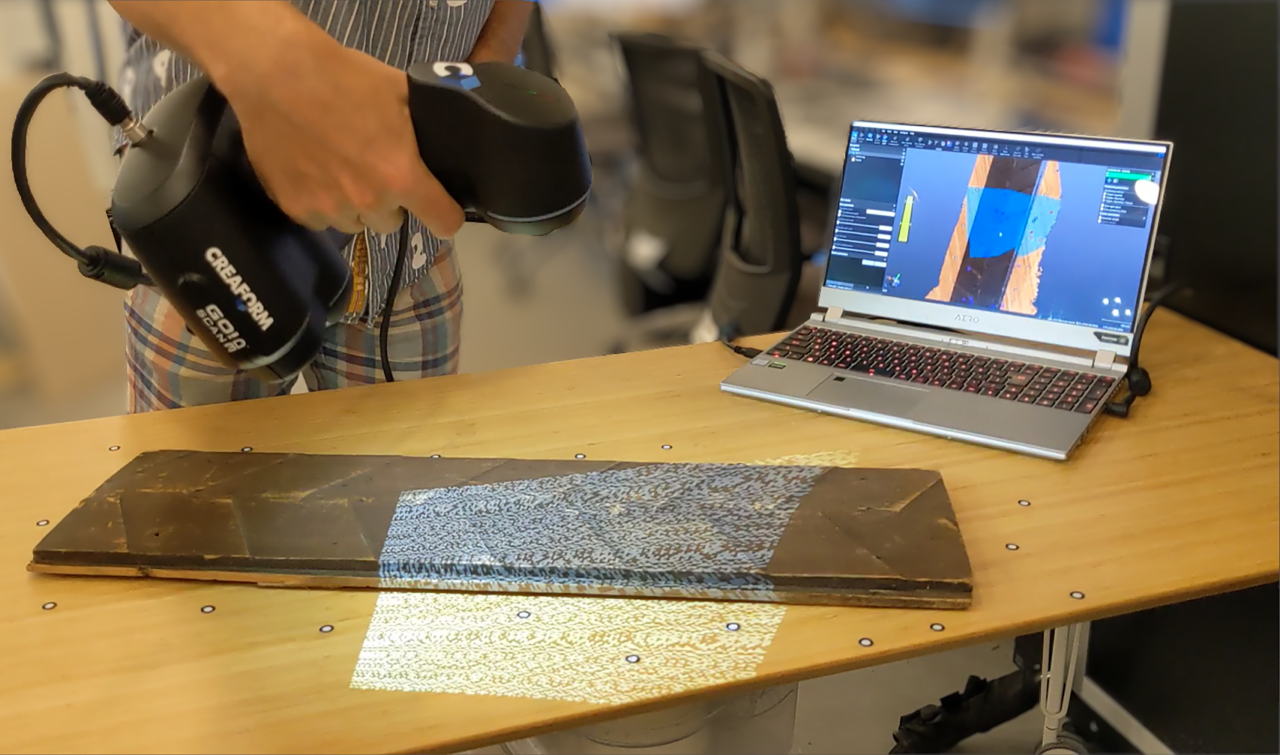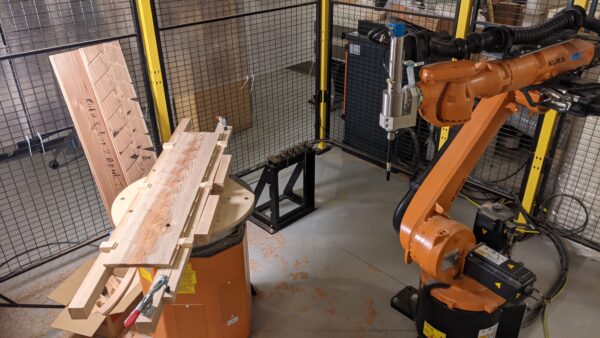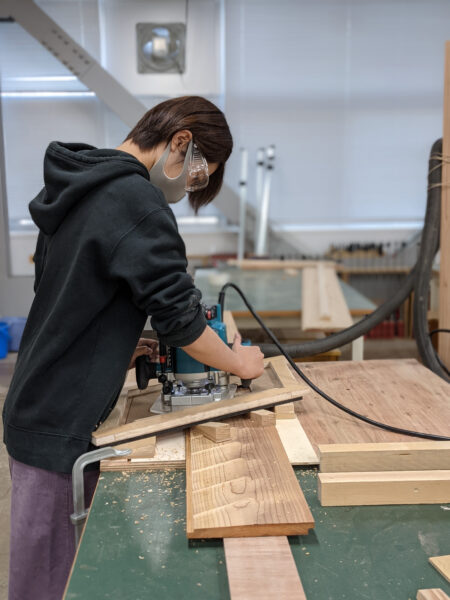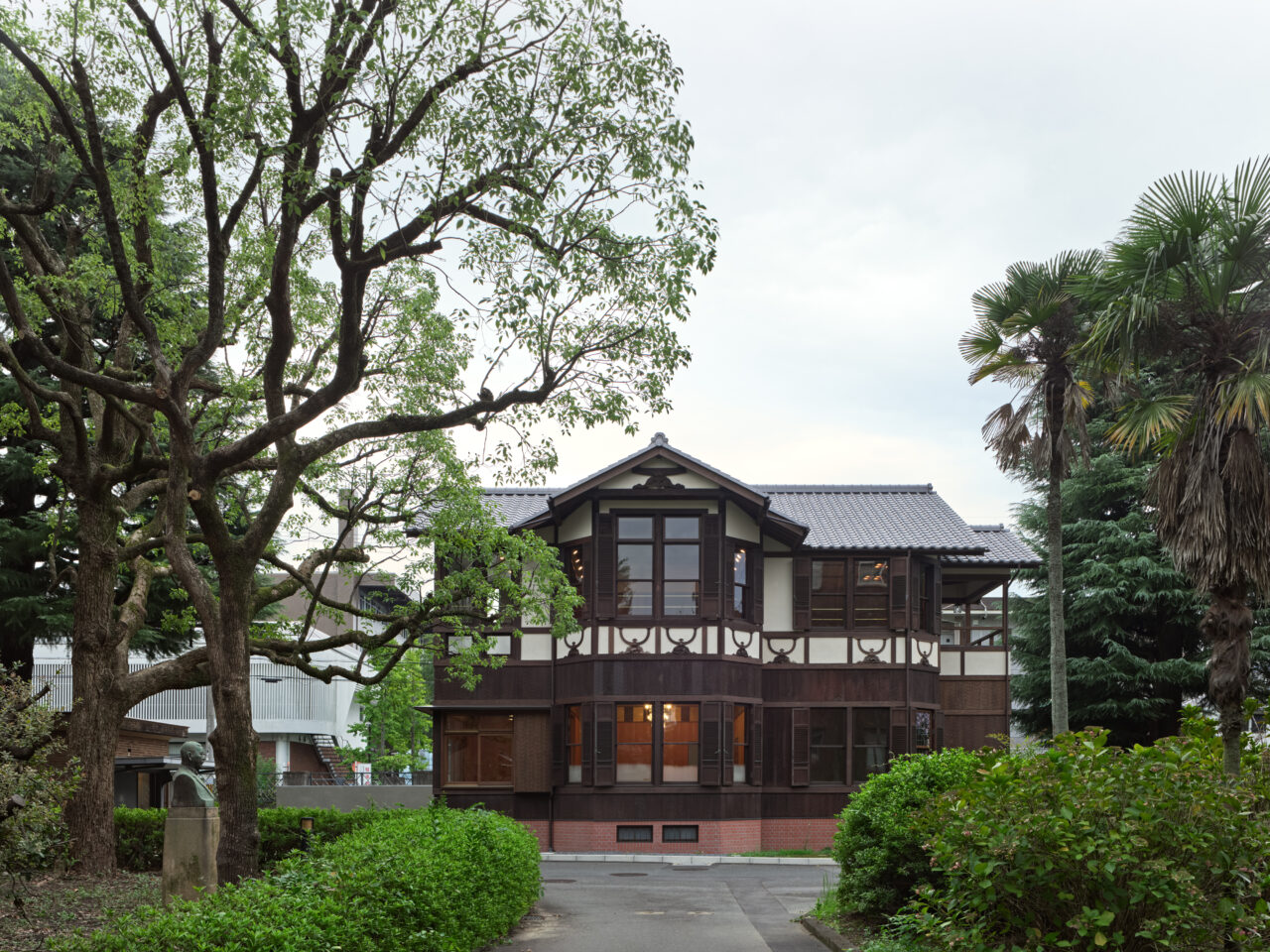京都工芸繊維大学「和楽庵」移築再生プロジェクト及び、同大学教育プログラム「dCEP」の「和楽庵サイバーハウス化プロジェクト」の中で実施された、「デジタルツールを用いた「和楽庵」ナグリ板参加型復元製作技術の開発」が、ウッドデザイン賞2021(ソーシャルデザイン部門)を受賞しました。
本プロジェクトは、2020年度に完了した「和楽庵」の京都工芸繊維大学松ヶ崎キャンパスへの移築再生事業の一環として、また「和楽庵」をフィールドとした大学院工芸科学研究科の工学教育プログラムDesign-centric Engineering Program(dCEP)の「和楽庵サイバーハウス化プロジェクト」と連携して実施されたものです。
KYOTO Design Lab のDesign Researcher in ResidenceであるBarna Gergely Péterを主担当者とし、移築再生事業及びdCEP和楽庵プログラムの担当教員である清水重敦教授、および中山利恵准教授との共同研究として進められました。
建築家武田五一が設計し大正5年に竣工した洋館「和楽庵」が本学構内に移築されることとなった際、この建物を大学の過去、現在、未来を象徴する建物とすべく、本来有する特徴から「拡張」というキーワードが抽出され、移築再生の設計とdCEPにおける「サイバーハウス化」を目指した実践的研究が同時並行で行われることとなりました。

本プロジェクトは、この「拡張」のコンセプトに則り、「和楽庵」の外壁に用いられていたナグリ仕上げの下見板の復元製作に取り組んだものである。本来は伝統技術によって製作されるナグリ板について、デジタル技術を用いてその復元製作を試み、また高い技術力を持たない学生がデジタル技術によってサポートされた製作技術によって実際の製作を行うという参加型の技術開発を行うことで、職人目線からの建築遺産の持続可能性における課題の解決方法を探ることを試みたものです。

Photo : Barna Gergely Péter
本プロジェクトが評価されたポイントは次の通り
「正確な方法がわからなった木材加工技術を、デジタルを駆使して再現した。手仕事の伝承をテクノロジーによって諮る新規性ある取組である。伝統建築の保存や伝承と木材利用の促進に貢献する。社会性の高い提案」
ウッドデザイン賞受賞データベースはこちら

Photo : Barna Gergely Péter
「和楽庵」ナグリ板参加型復元技術開発プロジェクト紹介

Photo : Yasushi Ichikawa
実業家稲畑勝太郎が明治38年(1905)8月に取得した別邸で、南禅寺旧境内の塔頭跡地に整備された、建物および庭園を含む別荘地の総称。そのうちの洋館は本邸として利用するにあたり建てられたもので、本学の前身校の一つである京都高等工藝学校図案科初代教授を務めた武田五一により和洋折衷の意匠を散りばめ大正4年に設計され、清水組(現 清水建設株式会社)の施工により翌大正5年(1916)に建立した。令和2年(2020)、この洋館を京都工芸繊維大学松ヶ崎キャンパス内に移築し、新たな機能を与えて再生するに至る。これを機に「和楽庵」を施設名とした。
[Warakuan] Naguri restoration development project won the Wood Design Award 2021 (Social Design Category).
The project is part of the “Warakuan” relocation and regeneration project in Matsugasaki Campus, Kyoto Institute of Technology in 2020, held in collaboration with “WARAKUAN Cyber House Project ” of the University’s Design-centric Engineering Program (dCEP). The project was managed as joint research with KYOTO Design Lab’s researcher-in-residence and project manager BARNA Gergely Péter, Professor Shimizu Shigeatsu academic instructor of dCEP Warakuan regeneration program and Associate Professor Nakayama Rie.
Western-style building “Warakuan” was designed by architect Takeda Goichi in 1916. The building is designed to symbolize the past, present and future of the university after it relocated to Matsugasaki campus. The keyword “expansion” was chosen from the original characteristics of the building and practical research is being conducted simultaneously during “cyber-house conversion” of dCEP.

The project focuses on the concept of “expansion”. The participants worked on restoration and production of Naguri technique used on the clapboards of the outer wall of Warakuan.
The traditionally made Naguri board is now restored and manufactured by students who don’t have high technical skills who carry out the production with support of digital technology. The aim of the project is to find solutions to the sustainability challenges of architectural heritage from a craftsman’s point of view.

Photo : Barna Gergely Péter
This project was evaluated as follows.
Reviving wood processing through the use of digital technology. Implementing a novel approach connecting the tradition of handicrafts and technology contributing to preserving traditional architecture and promoting the use of wood.
Wood Design Award is found here.

Photo : Barna Gergely Péter
Introduction of [Warakuan] Naguri restoration development project

Photo : Yasushi Ichikawa
The Western-style building was owned by businessman Inabata Katsutaro in August 1905, located on the former Nanzenji Temple precinct. The building was designed as main residence by architect Takeda Goichi 1915 who was the first professor of the department of Design of Kyoto Higher Technical School, one of the predecessor schools of the Kyoto Institute of Technology. Influenced by Japanese and Western architectural design, the building was constructed in 1916 by Shimizu-gumi (Currently. Shimizu Corporation). The Western-style building was relocated to the Kyoto Institute of Technology Matsugasaki Campus in 2020. Taking the opportunity of the relocation, the building was named “Warakuan”.